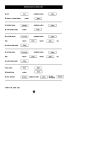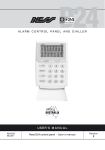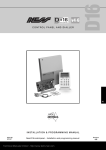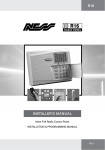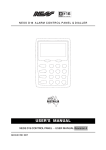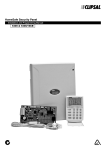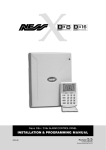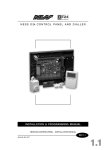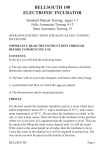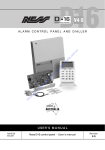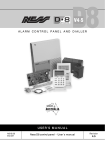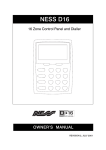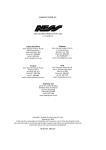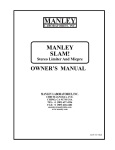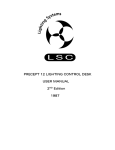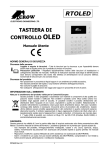Download PRO-LD - Ness Corporation
Transcript
PRO-LD DIALLER ALARM SYSTEM Installer Manual Quality Endorsed Company ISO9001 LIC.No. QEC2074 NSW Head Office only Ness Security Products Pty Ltd ACN 069 984 372 SYDNEY 02 8825 9222 MELBOURNE 03 9878 1022 BRISBANE 07 3343 7744 WWW.NESS.COM.AU N55 PERTH 08 9328 2511 ADELAIDE 08 8277 7255 NZ (NFS SECURITY) ©2000 Ness Security Products Pty Ltd. All rights reserved. PRO-LD Installer Manual V3.0 To the best of our knowledge, the information contained in this manual is correct at the time of going to print. Ness Security Products reserves the right to make changes to the features and specifications at any time and without notice in the course of product development. 64 9 573 0401 HONG KONG 852 2721 8097 INTRODUCTION The PRO-LD local alarm has been designed to provide you, the installer, with all your most requested features including, ease of installation, ease of programming and user friendly operation in a package which is functional and attractive. The new patented PRO Series polycarbonate cabinet continues NESS Security Products’ commitment to innovative design and quality, incorporating features never before seen in this type of product. The PRO-LD is an Australian designed and built product which is available at an affordable price without compromising quality or features. This manual will tell you all that you need to know about installing and programming the PRO-LD. For information about operating instructions, refer to the PRO-L User’s Manual. PACKAGE CONTENTS The PRO-LD package contains the following; l 1 x PRO-LD Control Board l 1 x PRO Series Cabinet l 1x l 1x Transformer l 10 x End-of-Line Resistors l x Spare Rechargeable Battery or Fuse l x PRO-LD Keypad l x PRO-L Zone List l x Conduit Clip l l x Installation Manual l x User Manual l 1 x Telephone Lead PRO-LD DIALLER TELEPHONE CONNECTION MOM 3/S SOCKET PROUI PLUG Pf?o-ul The PRO-LD dialler connects to a telephone line via a Mode 3 or 5 socket. A Mode 3 or 5 connection allows the dialler to cut-off any existing devices (e.g. phones, faxes) and “seize” the Telephone line for it’s own use, this is to ensure secure operation. If a mode 3 or 5 socket is not available on site then a mode 3 double adaptor which allows for a phone and a dialler to be connected can be purchased from retail outlets. The dialler must always be connected directly to the incoming phone line, connection to a PABX line will either dramatically lessen your security and increase your problems, or in some cases the dialler will not work at all e.g. a Telecom Commander System does not allow you to connect to the extension lines. The PRO-LD carries in Australia the Austel Permit A92/03/0365 Please note that under the Telecommunications Act 1991 it is illegal to tamper with or to wire into the tiers network for connection of telephones, diallers, Securitel devices etc. unless the work is carried out by or under the supervision of an Austel licensed wiring technician. Breaches of the Telecommunications Act leave the installer liable to prosecution with penalties of up to $12,000 per offence and immediate disconnection of any illegally wired devices. Your attention is also drawn to the Act which states that where a permitted alarm device is connected to a carriers network all cabling including connection to Keypads, Detectors etc. shall be carried out to Austel Technical Standards using Austel approved cable only. Note - wiring of the alarm system cables apart the telephone line connection does not require an Austel licensed technician to carry out the work. INPUTS ZONE INPUTS -The PRO-LD has 9 separate monitored inputs 8 x programmable zones 1 x Tamper Each input must be terminated with a 2k2 (2,200 ohm) end-of-line resistor as supplied. The input resistor tolerance is plus 1,200 or minus 900 ohms. Two end-of-line resistors may be used to secure two cable runs on one zone. See below for connection details. POWER - AC input - Connect the brown and blue wires (no polarity) from the NESS Plugpak to the AC terminals. The PRO-LD requires an A.C. transformer rating of 1.4A @ 16VAC minimum. BATTERY - Connect a sealed lead acid rechargeable 12V battery with a minimum capacity of 2.4 Ah to these terminals. Charge current is limited to 350 mA maximum. Charge voltage is factory preset at 13.8V via pot V 1. EARTH - For maximum protection against damage caused by lightning strikes to the phone line, connect a good earth to the earth terminal of the PRO-LD. The PRO-LD incorporates two 600 Volt Gas Surge Arresters from each phone line to earth and a 275 Volt M.O.V. surge arrestor across the two lines. 8 NESS Security Products OUTPUTS 12V OUTPUTS - A regulated 13.8V dc output is available to power detectors etc. This output is available from two sets of terminals marked "+12F2" and “OV”. It is fused by fuse F2 (1 .5A or 1.6A fastblow 2AG). A maximum load of 1A may be connected to these terminals. SIREN - An oscillating output, via Fl (1 or 1.6A fast blow 2AG) for connecting horn speakers. (3 x 8 ohm horns or 1 x 8ohm plus 1 x 4ohm) STROBE - A latched 12Vdc voltage output, fused via F3 (1.5A or 1.6A fast blow 2AG), for connecting strobes or piezo sirens. RESET - A non-latched 12V dc voltage output controlled by the Siren Timer, P29E and fused via F3 (1 .5A or 1.6A fast blow 2AG) for connecting piezo sirens, relays etc. Note: A total of 1.5A or 1.6A continuous is available from the reset and strobe terminals. SAT - The SAT terminal can be used to trigger satellites that require a highgoing-low input. The SAT voltage is nominally 13.8V via a 2k2 ohm resistor and less than 2V in alarm. J7 OUTPUTS - The outputs are open collector (switched negative) which can supply a maximum 50mA Outputs available are:- Area 1 (armed), Area 2 (armed), Alarm 1, Alarm2, Tamper, Exclude, Battery low, Mains off, 12V (ext. power). The J7 outputs can be used to trigger external relays, or drive LEDs. The Alarm 1, Alarm 2, Tamper and Exclude outputs latch until reset by a code. The siren relay and satellite outputs turn on for the alarm reset time or until reset by a code. J6 LISTEN PINS - Connect any 8 ohm(or greater) speaker to these pins to listen to the dialler progress. This is useful for fault fading . 9 PRO-LD REMOTE KEYPAD Installation Unclip the housing using a screwdriver to lever off the top half. Push the screwdriver hard into each of the two holes in turn and lever upwards. Unplug the keypad tail from the circuit board connector. Remove the PCB by lifting off the 2 retaining rubber grommets and lifting the PCB out. Screw the base to the wall using the 2 mounting holes provided. These holes match a standard switch plate spacing. Clip the board back into the base bringing the 4 connecting wires through the cable entry hole. Plug the rubber grommets back onto the posts provided. Connect the wires to the screw terminals or solder them to the B 1 solder pads. Plug the keypad tail onto the PCB and clip the top half onto the base by first engaging the bottom clips and swinging the top closed, push hard to ensure the clips engage. Stick the zone list to the inside of the hinged lid. Clip the hinged lid onto the keypad. Wiring The PRO-LD Keypad connects to the PRO-LD Control Panel via a 4 wire connection. (See page 11) A maximum of 5 keypads can be connected, each wired in parallel. The maximum cable run is 100m using 14/0.20 cable. If you want to share a cable run, then divide 100m by the number of keypads to be connected. e.g. 2 keypads on the one cable reduces the maximum run to 50m. 12 NESS Security Products Armed LED Option The Armed LED on the PRO-LD Keypad can be selected to indicate one of 4 options; 1/ 2/ 3/ A1A - Area 1 armed A2A - Area 2 armed A1B - Area 1 OR Area 2 Armed A2B - Area 1 AND Area 2 Armed only Select the option required by placing the jumper on J2 connector on the appropriate pins. The Keypad comes with the jumper preset to the A 1B position. ie. the armed LED will light when Area 1 OR Area2 are armed. For split system operation with separate keypads, use option 1 (Area 1) and 2 (Area 2) on each Keypad respectively. NOTE: It is possible to hard-wire your own LEDs if you require more than the one. Details are available from NESS. 0 0 WIRING DETAILS PANEL PRO-LD 13 PROGRAMMING OPTIONS SUMMARY User and Install Mode Access Access Code 1 - (master) .......................... P11E Access Code 2 ......................................... P12E Access Code 3 ......................................... P13E Access Code 4 ......................................... P14E Access Code 5 ......................................... P15E Access Code 6 ......................................... P16E Access Code 7 ......................................... P17E Access Code 8 ......................................... P18E Access Code 9 ......................................... P19E Access Code 10 ....................................... P20E Access Code 11 ....................................... P21E Access Code 12 ....................................... P22E Access Code 13 ....................................... P23E Access Code 14 ....................................... P24E Access Code 15 ....................................... P25E Entry Time1 .............................................. P26E Entry Time2 .............................................. P27E Exit Time ................................................... P28E User and Install Mode Access Alarm Time (Reset) ................................... Normal Sens Zones .................................. VIB SENS 1 Zones ................................... VIB SENS 2 Zones ................................... VIB SENS 3 Zones ................................... VIB SENS 4 Zones ................................... VIB SENS 5 Zones ................................... VIB SENS 6 Zones ................................... VIB SENS 7 Zones ................................... VIB SENS 8 Zones ................................... DoubleTrigger Zones ................................ Instant Zones ............................................ Entry 1 Zones ........................................... Handover Zones ....................................... Entry 2 Zones ........................................... Lockout Zones .......................................... Assign Area1 Zones ................................. Assign Area2 Zones ................................. Area1 Active Codes 1 - 8 .......................... Area1 Active Codes 9 - 15 ........................ Area2 Active Codes 1 - 8 .......................... Area2 Active Codes 9 -15 ......................... Monitor Zones ........................................... 24 hr Zones .............................................. Day Zones ................................................ Reset Output Zones .................................. Strobe Output Zones ................................ Sonalert Output Zones .............................. Siren Output Zones .................................. AL 1 Output Zones ................................... AL2 Output Zones .................................... 14 P29E P30E P31E P32E P33E P34E P35E P36E P37E P38E P39E P40E P41E P42E P43E P44E P45E P46E P47E P48E P49E P50E P51E P52E P53E P54E P55E P56E P57E P58E P59E Miscellaneous ........................................... P60E I Entry warning Beeps 2 Keyswitch monitor mode 3 Keyswitch Arming 4 Tamper siren lockout 5 Duress Reset Output 6 Auto Exclude Zones 7 Disable LEDs 8 O/P (A1 & A2) on after Exit Tamper & Panic Outputs .......................... P61E 1 Tamper to Reset 2 Tamper to Strobe 3 Tamper to Sonalert 4 Tamper to Siren 5 Panic to Reset 6 Panic to Strobe 7 Panic to Sonalert 8 Panic to Siren Shortcuts .................................................. P62E 1 Memory Display shortcut 2 Exclude shortcut 3 Monitor Arm shortcut 4 Panic shortcut 5 Area1 Arm shortcut 6 Area2 Arm shortcut 7 2 sec siren warning Auto Exclude 8 Exit Time x 10 Day & Monitor Outputs ............................ P63E 1 Monitor Reset Output 2 Monitor Strobe Output 3 Monitor Sonalert Output 4 Monitor Siren Output 5 Day Reset Output 6 Day Strobe Output 7 Day Sonalert Output 8 Day Siren Output Miscellaneous ........................................... P64E 1 2 second Monitor Alarm 2 2 second Day Alarm 3 Pre-Alarm Monitor Upload from Panel ................................... P96E Download to Panel .................................... P97E Return to DefauIt (only AccessCodes 1 - 15) . P98E Program Installation Code ......................... P99E PRO-LD DIALLER OPTIONS SUMMARY Telephone No. 1 (numeric entry only) ........ P70E Telephone No. 2 (numeric entry only) ........ P71E Client Code 1 ............................................ P72E Client Code 2 (Used for Area 2 Open/Close) .......... P73E Report Zone alarms .................................. Report Miscellaneous Alarms ................... Report Zone alarms Restored ................... Report Miscellaneous alarms Restored ..... Report Multiple Zone Alarms ..................... Zone Mapping to Client Code .................... P74E P75E P76E P77E P78E P79E Telephone No. 1 (inc *, #, and Pause) ....... P80E Telephone No. 2 (inc *, #, and Pause) ....... P81E Area Zone Restore Reports ...................... P82E 1 Immediately on Input resealed 2 After Siren Reset 3 After Opening + Input Sealed 4 After Opening Always Time between Test Calls (2 hr steps) ........ P83E Time before first Test Call (2 hr steps) ...... P84E Dialling Method ......................................... P85E 1 Automatic 2 Decadic (pulse) Dial 3 V.F. (DTMF) Dial Miscellaneous Reporting ........................... P86E 1 Ademco Extended/Audible Format 2 Enable Test Calls 3 Delay Mains Fail by 1 Hour 4 Ademco Extended (no checksum) Miscellaneous Dial .................................... P87E 1 Split Dial or Alternate 2 Dial without Dial tone 3 New Zealand Dial 4 4 or 10 Dial Attempts Miscellaneous Open/Close ....................... P88E 1 Send Area 1 Open/Close 2 Send Area 2 Open/Close 3 2 Sec. Siren on Closing 4 2 Sec. Strobe on Closing PRO-LD 15 PROGRAMMING Access To Program Modes from Initial Power Up When power is applied for the first time with the box tamper open, the panel will enter Install Program Mode (3 beeps + Prog light flashing) Access To Program Mode from Operating Mode The Panel must be fully disarmed (no area, no monitor on). Press You are now in User <MASTER-CODE beeps Prog light ste de. Then to enter Ins <INSTALL CODE> (3 beeps - Prog led flashing) Note: Default install code is 000000 NOTE: For security purposes, the Install Code on its own will not allow access to Install Program mode. The Master Code must be entered first. How To Program The program sequence always follows this pattern; <2 digit option> eps if OK, 1 long ( The lights will display status or value. Enter the new val <New Value? t Display new value, 3 beeps To Clear Programme Information (from install mode only) Press; P 98 E to clear access codes 1 to 15 NESS Security Products LOCAL DOWNLOAD/UPLOAD The PRO-LD control panel contains a unique method of programming or storing all of its programmable options onto a tiny board called the PRO LDU. The PRO LDU allows you to upload an existing program (for servicing, storage or use as a master program key) from a PRO-LD panel. Alternatively you can take an existing program stored on a PRO LDU and download it into a PRO-LD. Use of the PRO LDU can save time in programming (you could keep 4 or 5 commonly used programs since the information is non-volatile and will last up to 10 years in storage) and will save time when servicing. To use the PRO LDU1. Plug the PRO LDU onto J3. The LED will light on the LDU to show correct connection, 2. Place the PRO-LD panel into install program mode, 3. To upload or store a program to the PRO LDU, press P96E The PRO-LD programmed options are copied to the PRO LDU 4. To download a program from the PRO LDU to the PRO-LD, press P97E. The PRO LDU options are copied to the PRO-LD. Write Protection The PRO LDU has a link which is accessible from the top of the board. Remove the link to write protect the stored information on the PRO LDU. This will prevent accidental erasure of information you wish to keep. PRO LDU Jumper OPTION DESCRIPTIONS Codes The PRO-LD has a total of 16 operator codes. One code is the installer access code and is used only for access to Installation Program Mode. The remaining 15 codes are used for arming/disarming etc. These codes are assigned user numbers 1 to 15 (options 1 l-25). - User 1 is the master code. The master code is the only code which can access User Program Mode. - Codes can be 3 to 6 digits in length. - User codes cannot start with " 0 " To clear an existing code you must re-program that code with a number that starts with “0”. For more information on codes see “PRO-L User Manual” The installer code is defaulted to “000000” (option 99), this is an optional code. To Clear codes, use P98E in Install Program Mode. Area Operation The PRO-LD Control Panel allows for the 8 zones to be split into two groups known as Area 1 and Area 2. The two Areas can be assigned access codes so that a user may have access to either Area 1 or Area 2 or both Areas. This allows for partial Arming of the premises or protecting two separate premises with one PRO-LD. (Eg,. Petrol Station and Workshop.) Options 45-50 are used to assign zones and codes to Areas. The default is all codes and all zones selected to Area 1. Arming and Disarming is carried out as normal. You may install a Keypad in each Area with its own Armed Led. (See page 11.) Area operation only applies to zones when they are in the armed state, this means that day, 24hr and monitor zones are independent of the area operations. 18 NESS Security Products Zone Assignment All zones can be programmed to operate in all 3 Panel Modes i.e. a Night Zone, as well as Monitor Zone and also a Day Zone. These zones must always exist in Area 1 or Area 2 to operate. These Zones can be programmed to turn on different outputs for each Mode of panel operation when they alarm. These zones can also be programmed to be one of 4 types; Instant, Handover, Entry Delay 1 and Entry Delay 2. Zones may be programmed to operate as 24 Hour Zones where they automatically operate in all of three modes (Night, Monitor, Day). These zones work independently of Area 1 and 2. Therefore, a 24 Hour zone cannot be selected in an Area. When alarmed, these zones will always turn on the same outputs regardless of the Panel Mode. 24 Hour Zones are always Instant. ZONE MAPPING OPTIONS Only One Per Zone 20 NESS Security Products I I I I ZONE TYPE DESCRIPTION Instant Zones P40E Instant zones operate only in the Armed state. When Armed, these zones will not operate for the programmed exit time (P28E). At the expiry of exit time these zones will activate assigned outputs immediately if they are alarmed. Entry 1 Zones P4lE (l-99 seconds) Entry 1 zones operate only in the Armed state. When Armed these zones will not operate for the programmed exit time (P28E). At the expiry of exit time these zones will activate an entry 1 timer (P26E) if they are alarmed. If the entry 1 timer is activated a code must be entered to reset the timer. If not reset at the expiry of the entry 1 timer, the entry 1 zone outputs will be activated. NOTE: During entry 1 timer activation the sonalert will BEEP as a pre-alarm warning. To disable entry beeps, program P60E 1E Entry 2 Zones P43E (10 - 990 seconds) As per entry 1 above but utilising entry 2 timer (P27E) which is set in 10 second increments instead of 1 second increments. Eg. 60 secs = 6 Handover Zones P42E Handover zones operate as per “Instant” zones above with the exception that if either one of entry 1 or 2 timers has been activated then the handover zones will be inoperative for the duration of those times. NOTE: Zone alarms (other than Day and 24hrs) can only be reset by a code assigned to the Area that the zone alarm occured in, however the siren output can be reset by any valid code. 24 Hour Zones P52E 24 hour zones operate at all times regardless of the mode of panel operation, ie. Armed, Disarmed or Monitor. When alarmed, these zones will activate assigned outputs immediately. To reset those alarms any valid user code must be entered. PRO - LD 21 Dav Zones Day zones operate only when the panel is in a totally disarmed state, ie. no areas Armed or Monitor on. When armed, these zones will activate the assigned outputs immediately (instant operation). -If 2E is selected, Day Zones will turn on the outputs assigned by Option 63 for 2 seconds. This is useful for daytime monitoring. -If 2E is not selected then the Day Zones will turn on the outputs assigned to the zones (option 54-59). The outputs will behave as normal. Use this setting for dedicated Day alarm zones. Monitor Zone Monitor zones are used primarily for securing perimeter or high risk zones while a residence is occupied. Monitor mode allows a user to Arm those zones with a simple keypad operation. Monitor zones will only operate when the panel is in the Monitor mode i.e. Armed LED flashing. If is selected then the Monitor zones will turn on the outputs assigned by option 63 for 2 seconds. If is not selected then the Monitor zones will turn on the outputs assigned to the zones (option 54-59). The outputs will behave as normal. If 3E is selected then the Monitor zones will all behave as Entry/Exit zones. This allows the user to have a pre-alarm warning of a monitor If 3E is not selected then the Monitor zones will behave as programmed for the zone types (options Siren Lockout All 8 zones and tamper input can be programmed to lockout, ie. cause the siren to sound only once whilst the panel is armed. The siren is “locked out” for that zone until the panel has been reset by entering a valid code. DEFAULT = ALL ZONES LOCKOUT Tamper is defaulted to lockout. If you wish to change it, program 4E NOTE: Only the first zone to cause an alarm will lockout while the sirens are sounding. 22 Security Products Sensitivity P38 - 39E The 8 zones of PRO-LD can be programmed with one of 9 sensitivities. Normal, (P 30 E), the zone must be unsealed for 200ms continuously. Vibration Sensitivities 1 to 8 (P 3 1-38 E). This is used with “Nessensors”. Sensitivity 1 is the most sensitive and sensitivity 8 the least sensitive. NOTE: Sensitivity 1 and 8 should not normally be used, they are provided as a guide to the upper and lower limits only. Double Trigger P39E All 8 zones can be programmed to be double trigger, ie. the zone has to alarm twice within 4 minutes before the panel will recognise an alarm condition. The PRO-LD also incorporates our unique setting, whereby if any 2 zones which are programmed to be double trigger, alarm once each, an alarm is generated so as to not to lessen security. NOTE: If a double trigger zone is left unsealed for longer than 15 seconds then an alarm is generated as a safety override. ON = YES DEFAULT PRO - LD I 23 Output Assignment P54 - 59 E. P61 & 63 E When a zone alarms, it can turn on any or all of the following 6 outputs; Sonalert, Strobe, Siren, Reset, AL 1, AL 2. The programming is selected with options 54-59. Simply set the zone number to the output to select it. The zone LED will indicate if the zone is selected. The Tamper input and the Keypad Panic can be programmed to turn on the Reset, Strobe, Sonalert and Siren. Programming is achieved using option 6 1. Monitor and Day are assigned in the same manner using option 63. Tamper and Monitor outputs are displayed on zone LEDs 1-4 while Panic and Day outputs display on zone LEDs 5-8. (See table below) OUTPUT MAPPING Option Output 58 Zones AL 1 NOTE: the Reset, Siren and Satellite output will turn on for the duration of the alarm timer (P29E) or until it is reset via a valid code. The Strobe, AL 1 and AL 2 outputs latch until reset by a valid code. Kev Operation Shortcuts P62E Keypad operations can be programmed to operate with or without (shortcut) a user code. The operations available are; entry to Monitor mode, Exclude and Memory modes, Arming and keypad Panic. The default is Arm with code, all other operations shortcut. Operations With Code, example; To Arm, press <ARM> <CODE NO> <ENTER> Operation Short Cut, example; To Arm, press <ARM> < ENTER> NOTE: Never program Arm Area 1 and Area 2 shortcut (5E & 6E) together without allocating an access code to Area 2. If you do so and Arm both areas, Area 2 will remain armed which will bar entry into program mode until Area 2 is disarmed. 24 NESS Security Products Kevswitch P60E 2E 3E A normally open momentary keyswitch can be used to Arm, Disarm or change the PRO-LD to Monitor mode. If a keyswitch is required it is wired to zone 8 as shown (obviously zone 8 is no longer used as an alarm input) NC. C Z8 Option 60, 2 or 3 must be programmed to allow keyswitch operation. Option 2 allows change to Monitor or Disarming only, on each momentary keyswitch contact of greater than 200 ms. Option 3 allows Arming and Disarming only, on each momentary keyswitch contact of greater than 200ms If Option 2 and Option 3 are both programmed, the Panel will cycle through all three operating modes on each 200ms keyswitch contact, ie. NOTE: Momentary keyswitch operation allows for more than 1 keyswitch to be used - just add more switches in parallel. If the input is opened, a full alarm will occur. Use this feature to add an additional panic button in series with the 2k2 resistor. WARNING - The Keyswitch will Am and Disarm Area 1 and Area 2. Always Disarm both Areas to allow entry to Program Mode. PRO - 25 Auto Exclude P60E 6E Zones are programmed to auto exclude (no alarm) if they are unsecured at the end of exit time. If you require the zone to alarm if unsecured at the end of exit then unset P60E 6E. End of Exit/Auto Exclude Warning P62E 7E If you require a 2 second siren burst at the expiry of exit time to indicate a faulty auto excluded zone, then program P62 7E. l Duress To generate a silent duress alarm (ie. an alarm to indicate a forced disarm), simply prefix an existing user code with either digits 5, 6, 8 or 9 (when disarming). eg. to Disarm normally, press 2391 <ENTER>. To Disarm with a Duress, press 52391 <ENTER>. The duress alarm can be programmed to activate the Reset output (option 60E 5E) Keypad Tamper A keypad tamper alarm will be generated after 4 successive attempts to enter an invalid code. The keypad tamper alarm outputs are the same outputs as programmed to external tamper. Extended Exit Time P62E 8E If you require a longer than normal exit time you can multiply your exit time (P28E) by 10 by programming P62E 8E. e.g. P28E = 22 seconds if P62E 8E is set then exit time = 22 x 10 = 220 seconds. Display Disable P60E 7E The LED indicators on the keypad can be programmed to blank after 4 minutes of no keypad use (useful to stop annoying lights in a bedroom). To blank the display program P60E 7E. Beeps, or pressing any key will restore the display. (Use <ENTER> preferably.) Area 1 and Area 2 Outputs P60E 8E The outputs marked area 1 and area 2 on connector J7 turn on immediately Area 1 or Area 2 are armed. If you require them to turn on only after exit time has expired then program P60E 8E 26 NESS Security Products DIALLER OPTIONS The PRO-LD Control Dialler communicates all of its alarm information via a standard telephone line to a Central Monitoring Station using Ademco Extended High Speed Format. To minimize the amount of programming required to make the dialler operate correctly, all of the available alarms have been allocated to fixed channels and cannot be re-programmed. You will find in practice that since only 15 Alarms are available for transmission and the Ademco format allows for 16 Alarm channels to be transmitted, it is not necessary to re-map these channels. All re-mapping can be handled at the Central station. All of the 15 alarms are reported on client code 1. The table below indicates the allocation of Alarm channels in the PRO-LD; I With 9th CHANNEL = 7 (CHANNEL 1 - 8) ZONE CHANNEL 1 1 2 3 4 5 6 7 8 2 3 4 5 6 7 8 With 9 t h CHANNEL = 1 (CHANNELS 9 16) MISC. ALARM CHANNEL ID uress I 1 Keyswitch Panic 2 Keypad Panic 3 Spare 4 Panel Tamper 5 External Tamper 6 Keypad Tamper 7 Instal Prog. Entry 8 PRO LD 27 Telephone No. 1 P70E P 70 E Telephone no. E Telephone No. 1 may be up to 14 digits only ( 0, 1-9). This is the Main telephone number for your central monitoring station. If you require pauses or the V.F. digits * or # to appear in your number then use program option P 80 E. To clear telephone No. 1 program option P80E. Telepone No. 2 P71E P 71 E Telephone no E Telephone number 2 may be up to 14 digits only ( 0, l-9). This is the back-up telephone number for your central monitoring station and is optional. If you require pauses or the V.F. digits * or # to appear in your number then use program option P 8 1 E. To clear telephone No. 2 program option P8 1E. Client Code 1 P72E P 72 E digit code E This is the identification code for all alarms and Area 1 open/close reports. Client Code 2 P73E P 73 E digit code E This number is only used to report Area 2 Open/Close messages. Program this code if Area 2 Open/Close reports are to be sent. Dialler Disable If you wish to disable the Dialler functions altogether, clear telephone No. 1 (see P80E). This may be useful if you want to enable monitoring at a later stage. 28 NESS Security Products Telephone No.s 1 & 2 with Pauses, * and # P80E P81EPP P 80 E or P 8 1 E Telephone no, P, extra digit E P P To program Pauses of 1.6 second duration and or the V.F digits * or # then a special programming method is used which is unique to the Telephone programming only. To include one of the special digits in the telephone number programming you must first press the Program key (this works like a Shift key on a calculator) and then Digit 1, 2 3 or 0. Where: 1 = 1.6 Second pause. 2 = V.F. * 3 = V.F. # 0 = Clear the number. When you have finished programming your telephone number by pressing Enter, you must also press the Program key twice to save the new values. Example 1 To program Telephone number one with 624-3655 starting with a 0 to access a PABX with a pause after the 0 then press; P80E 0 P1 6 2 4 3 6 5 5 E P P . Example 2 To program Telephone number two with a Telecom Easy Dial number 23 ending with a *, then press; P81E 2 3 P 2 E P P . When the PRO-LD displays the telephone number, the following lights are used to display the special digits; = TAMPER LED PAUSE * = LINE LED # = ARM LED Example 3 To clear Telephone No. 1 then press, P80E PO E PP NOTE: If both telephone numbers are cleared, then all dialler reporting is disabled. If telephone number 2 is disabled, all calls are made on telephone number 1 and the setting of P87E 1E has no effect. To view telephone No. 1 or No. 2 use P70E or P7 1E. WARNING - If you enter P80E or P81E you must press the Program key twice to exit the special program mode - even if you don’t want to program anything. PRO - LD 29 Alarm Reporting P74 - 79 E The zone alarms and the miscellaneous alarms may be selected to ; Report/Don’t Report, Send Restores/Don’t send Restores, and Send Multiple . alarms/Don’t send Multiple alarms. Option P79E allows you to select which Client Code to report the Zone alarms and excludes to. If the Zone LED is OFF, then the Zone alarms and excludes are reported on Client code 1 (this is the default). If the Zone LED is ON, then the Zone alarms and excludes are reported on Client code 2. ALARM TABLE Displayed on 1 8 ON = YES REPORT RESTORES REPORT MULTIPLE USE CLIENT CODE 2 Dures Displayed on 1 8 ON = YES K’pad Spare Panel Ext Kpad Install REPORT ALARMS REPORT RESTORES . Default Zone Restore Reporting P82E P 8 2 E option E Default = 4 To select when the dialler will send zone Restore reports select one of the following values. 1 Immediately the input restores 2 At the end of siren time (with input restored) 3 After Opening (with input restored) 4 After Opening (regardless of input state) Miscellaneous Alarms Restore Reporting Miscellaneous Alarms which have been selected to send a Restore report (P77E) will always send the Restore report when a valid code is entered to reset an alarm or at Opening. 30 NESS Security Products Time Between Test Calls P83E P83E Time E Default = 84 (168 hrs) The PRO-LD can send automatic test reports with an interval between 2 and 198 hours in 2 hour increments. Note - the value programmed is 1 to 99, this is multiplied by 2 by the PRO-LD to derive the Test Call time. Time Before Next Test Call P84E P84E Time E Default = 0 This is the time set before the PRO-LD generates it’s next test call, use this to set your preferred time for test calls. If you want the call to occur immediately then program this value to 0. The time before next test call is programmable from 2 to 198 Hours as per the Time between test call option above. The time before the next test call is constantly updated. When it is viewed the current value will be displayed. Dialling Method P85E P 8 5 E option E Default = 1 1 = Automatic, dial in the format of the Dial Tone. 2 = Decadic (pulse) Dial only. 3 = V.F. (DTMF) Dial only. Note - If no tone is detected after looping the line then the dialler will attempt to dial regardless using Decadic first and then V.F. dialling in an alternate method. Miscellaneous Reporting Options P86E P 8 6E option E Default = 1 ON, 2 OFF, 3 ON, 4 OFF 1 - On = Ademco Extended High Speed, Off = Audible Format 2 - On = Enable Test calls, Off = Disable Test calls 3 - On = Delay Mains Fail report by 1 Hr Off = No delay 4 - On = If Ademco format, do not send checksum. Note - Removing the checksum may make this format suitable for some receivers that do not recognise the extended format. PRO - LD 31 Audible Dial Format P86E 1E To select Audible format press; P 86 E 1 E (led off) (This will toggle the Ademco High Speed option off.)Audible format works in the following manner; 1. When triggered the PRO-LD will call the programmed telephone number 1 as normal. 2. At the end of the dialling sequence, the PRO-LD will wait to hear an acknowledge tone for a fixed period of 15 seconds. 3. If the PRO-LD receives no acknowledge tone it will output a series of DTMF tones (this is actually a standard high speed message report) lasting for about 8 seconds. The dialler tones sound like a series of fast beeps. 4. The dialler needs to be kissed-off (shut down) by pressing any of the following buttons - 2, 3, 5, 6, 8, 9, 0 or # on a phone capable of outputting tones. The button should be pressed continuously until the tones from the dialler have stopped. If tone is not available on the telephone, then a hand held tone generator can be used - these are available from Dick Smith, Tandy and similar electronic retail outlets as used with answering machines. 5. If the dialler does not receive the kiss-off tone it will re-dial and repeat the sequence, this will continue for up to 9 dial out attempts. 6. If the phone is answered prior to the 15 second wait time as described in 2. above, there will be silence until the time has elapsed. The message from the dialler may be started by pressing any one of the buttons as described in 4. above, the tone generated by the phone acts as an acknowledge tone. NOTE: Some telephones that are capable of outputting tones may only output the tone for a very short period. This will sound like a beep instead of a continuous tone when a button is pressed. This type of output is unacceptable and will result in intermittent operation, a hand-held generator would be recommended in this case.If you are using a Telecom 200 series phone you may need to press the MODE button to allow tones to be generated particularly if tone dialling is not available at the telephone exchange. Refer to the phone manual if you are unsure of its use. 32 NESS Security Products Miscellaneous Dial ODtions - P87E P 8 7 E option E Default = 1, 2, 3 ON, 4 OFF 1 - On = Alternate dial i.e. Dial telephone No. 1 first, if no answer, dial telephone no. 2, continue alternating until successful. 1 - Off = Split dial i.e. Dial Telephone No. 1 for half of the call attempts, if unsuccessful, Dial Telephone No.2 for the last half of call attempts. NOTE - Option 1 is only relevant if you have programmed Telephone No. 2 otherwise ignore it. 2 - On = Dial without Dial-tone only after attempting to obtain a valid tone first. The PRO-LD will dial Decadic first and then V.F. 2 - Off = Dial immediately without a Dial-tone, use for PABXs with non-standard Dial tones etc. 3 - On = Dial Australian Decadic, Off = New Zealand Decadic 4 - On = Make a maximum 4 dial attempts before a 5 minute sleep and 4 more retries if unsuccessful. 4 - Off = Make a maximum 10 dial attempts before a 5 minute sleep and 10 more re-tries if unsuccessful. Miscellaneous Open/close Reports - P88E P 8 8 E option E Default = 1, 2 ON 1 = Send Area 1 Open/Close reports (Off = Don’t send). 2 = Send Area 2 Open/Close reports (Off = Don’t send). 3 = Give a 2 Second Siren burst on a successful Closing report. 4 = Give a 2 Second Strobe on a successful Closing report. Options 3 and 4 are normally used to give the User an indication that the Dialler is working correctly when they Arm their system and leave the premises. PRO - LD 33 SOFTWARE UPGRADE HISTORY This manual is current for Version 1.4 software. Version 1.4 option additions are: P79E Zone Mapping to Client Code. (Page 30) P82E 4E Send Restores on Opening always. (Page 30) P86E 4E Transmit Ademco Extended Format without checksum. (Page 3 1) P87E 4E Dial 4 or 10 attempts. (Page 33) Other software enhancements in the V1.4 upgrade: a) Entry beeps now stop when a button is pressed on keypad. b) Zones which have sent an alarm report to a central station will now report a 6 (Outstanding) until re-sealed, instead of a 5 (Normal) in Ademco format. c) Test reports now include the status of Zones 1 to 8. d) Arm/Disarm, Mains Fail or Low Battery beep warnings added. e) A Zone is restored when the Area that it is in is Disarmed, previous versions required both areas to be Disarmed. f) Entry 2 Zones triggered were causing any subsequent Entry 1 Zones to have long delay times, this is fixed in this version. g) Code 8 could not be selected via the P47E and P49E options however it could be selected by P48E and P50E. This has been fixed. h) Turning the display back on after being extinguished with the P60E 7E option is now done automatically whenever the beeper sounds. i) If Audible format is selected, Manual and Auto-Excludes will not report. j) Restores are now sent for Duress, Keyswitch Panic and Keypad Panic. (Page 30). Version 1.4 software or greater requires the resistor R7 on the PRO-L(D) to be changed from a 15K 1% to a 12K 1% type (alternatively a 56K 1% could be added in parallel with the existing 15K 1% resistor). If a software upgrade is carried out without this modification, the keypad will not work properly with key presses being read incorrectly. Version 1.4 and earlier software has a software bug which renders the Program option P64E 4E (chirp the reset and strobe output on Arm and Disarm) virtually unusable. The problem arises when the panel is disarmed using the Keyswitch input, the alarm output’s (siren, reset, strobe, etc.) do not work in the disarmed state. Therefore Tampers, Keypad, Panic and 24 hour zones will not sound the siren in the disarmed mode if P64E 4E is set. Note - The option is still selectable but reference removed from this manual. 34 NESS Security Products TROUBLESHOOTING SYMPTOM CAUSE REMEDY Keypad not working correctly. Keypad wired incorrectly or excessive cable resistance. Check keypad wiring for polarity and resistance. Note the cabling restrictions on page 10. User code not being accepted. Code already programmed for another user or code forms a subset of another. Select another user code. Note the restrictions of code sub-sets in the user manual. User code is programmed successfully but not accepted in normal mode. Code programmed to begin with the digit "0" Reprogram the code. User codes beginning with "0" are used to clear codes. Cannot access install program mode. - Install code entered in run mode instead of user program mode. - Enter user program mode first using a master code, then enter the install code. - Install code lost. - Power down the system fully, then power up with the box tamper open. Cannot make PRO LDU download/upload. PRO LDU not plugged in correctly. Plug the PRO LDU in and check the LED lights. Control Panel not starting up when A.C. voltage IS Excess load connected to the power supply. Current limit protection operating. Check for short circuits and excessive load on the power supply outputs. For security, Client Program mode automatically exits if no keys are pressed within 4 minutes. Avoid leaving the Panel in program mode without The Heat Sink is warm to touch. Normal operation. This is normal operation. Sirens, Strobes or Detectors not working. Blown Fuse. Check for short circuits on outputs and replace blown fuse. The internal and external sirens sound for two seconds at the end of exit time. The Panel has been Armed with a zone unsecured. Disarm, then secure all zones and re-arm. The Battery light is flashing. The Panel has been powered up initially on AC. The battery IS not connected or the battery is flat. - Arm and Disarm the Panel to force a dynamic battery test. applied Panel automatically exits Client Program mode. PRO-LD Pressing buttons for long periods of time. - Connect the battery, or replace the battery. 35 SPECIFICATIONS 3mm Polycarbonate (equivalent to 1.2mm mild steel) Construction Dimensions 350 wide x 270 high x 120 deep 4.2kg (inc battery) Weight Input 240 Vac, Output 17Vac @ 1.4A Plug pack 13.8Vdc @ 1.25A (current limited) Power Supply 140mA with 1 Keypad - 20mA per additional keypad Quiescent Current 9.5V - 14V dc Operating Voltage Rechargeable Battery 12V 2.4 - 6.5Ah Lead Acid Batt. Charge Voltage 13.4 - 13.8V float Batt. Charge Current 350mA max. current limited Dynamic Battery Test Every hour and when the panel is armed Dynamic Battery Test 10.75V with 5A load 2 x 1.5A or 1.6A fast blow (5 x 20mm 2AG) Fuses End of Line Resistor 2,200 ohm (+1,200 -900 ohm) Zone Input End of Line Resistor 2,200 ohm (+1,200 -900 ohm) Tamper Input Remote Keypad Input Proprietary Maximum Keypads 5 Open Collector Fused (1.5A or 1.6A) 500Hz - 2700Hz Siren Outputs 3 x 8 ohm or 1 x 8ohm + 1 x 4 ohm Maximum Sirens Open Collector fused 230mA @ 12V 500mA 10V Strobe Output Open Collector fused 1.5A or I .6A Reset Output Switch Satellite Trigger Open Collector 2K2 pull-up 13.8V nom. 1.6V alarm Misc. Alarm Output Open Collector 50 mA @ 12V (J7) connector Power Output for 1A @ 12V Optional Equipment Austel Permit Number A92/03/0365 Important Test Points and Voltages 12 V Output Terminals 13.2 - 13.8V (load connected) Battery Terminals 13.4 - 13.8V (no battery connected) Zone & Tamper Inputs 50% of 12V output 5% (eg. 12V o/p = 13.6V, zone = Siren and Strobe + 12 Terminal via fuse F1 A.C. Terminals 17 - 23Vac P.N. 890-073 Version 3 I



































